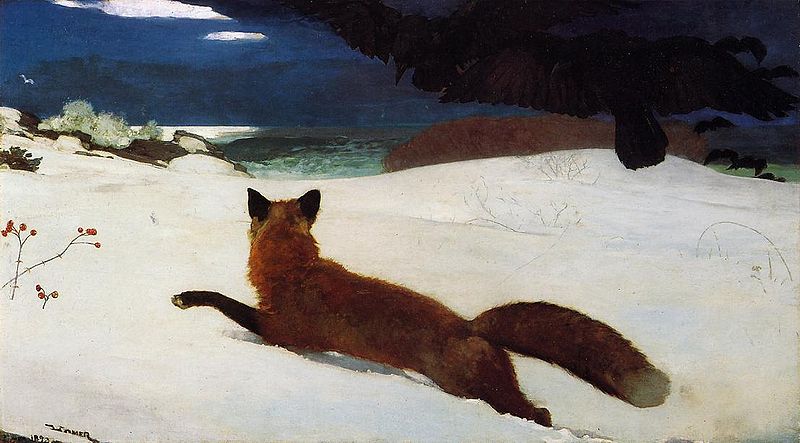| The Fox Hunt | |
|---|---|
 |
|
| Artist | Winslow Homer |
| Year | 1893 |
| Medium | Oil on canvas |
| Location | Pennsylvania Academy of the Fine Arts |
| Dimensions | 38 × 68.5 in |
| 96.5 × 174 cm | |
| Famous Paintings by Winslow Homer | |
| Snap the Whip | |
| The Gulf Stream | |
| Breezing Up (A Fair Wind) | |
| Right and Left | |
| The Fox Hunt | |
| Eight Bells | |
| The Life Line | |
| The Herring Net | |
| The Blue Boat | |
| Complete Works |
Winslow Homer was born in Boston, Massachusetts, but had an art studio in Prouts Neck, Maine, where he created The Fox Hunt painting. Homer worked with oil paints on canvas, and was known for his nature, landscape, and marine themes. The Fox Hunt was Homer’s first work of art to enter a major museum collection, and it began the process of his future financial security, within the following several years. Homer’s The Fox Hunt, completed in 1893, was purchased by the Pennsylvania Academy of the Fine Arts, in Philadelphia, after it was on exhibit in the academy’s annual show.
Description
The scene is mid-winter, along the New England coast. The center figure, the fox, is shown to be struggling through the heavy drifts of snow, looking for food. The fox seems aware of a flock of black crows, hovering and circling, also looking for food. In Maine, it is natural for flocks of starving crows, to actually attack a fox as food after a long winter. The crows rely on their large numbers and the weakened condition of the fox. The fox seems at a disadvantage in the painting, as it is slow to advance in the deep snow, making it very vulnerable and difficult to defend himself in the vast landscape of white snow.
Homer uses deep colors, and intricate detail. Motion and depth are shown by the shadowing effect under the fox. Waves are painted crashing on the jagged rock, with greenish-white splashes of brushstroke, and very thin, fine strokes, portraying branches of vegetation emerging from the deep, white snow. A twig or two of the former summer’s red berry bush are still peeking out, adding a redeeming factor, in this cold, somber scene.
Models and Symbolism
Winslow Homer used a fox’s pelt, supplied by a friend who was a hunter, and draped it over a barrel in the snow at his studio, to accurately paint the colors of the fox. He also was supplied with crows, which he strategically placed, but found with the warming temperatures, became limp. He instead scattered corn on the ground to attract live crows, and sketched them, as a reference to be repainted in The Fox Hunt.
The overall view of The Fox Hunt was that it was a Darwinian painting, portraying survival of the fittest. Several writers interpreted the fox as Homer’s self-portrait, resembling the small, inquisitive, and shrewd qualities of the fox. It is possible that Homer identified with the fox’s social aloofness and shyness as well. In the lower left corner, the artist’s signature is seen sinking in the snow, like the fox. The “R” in his signature, also resembles the fox’s tail. The largest of his paintings, The Fox Hunt is still displayed today at the Pennsylvania Academy of the Fine Arts.